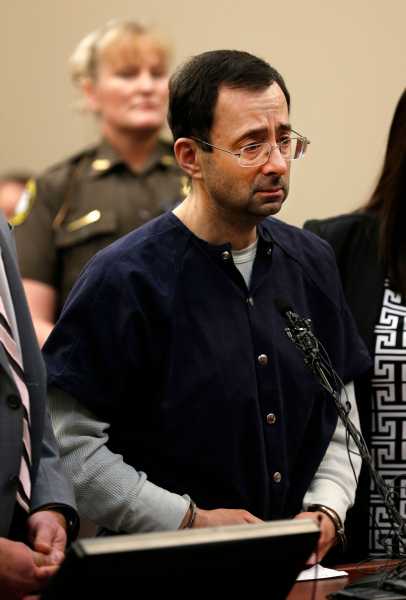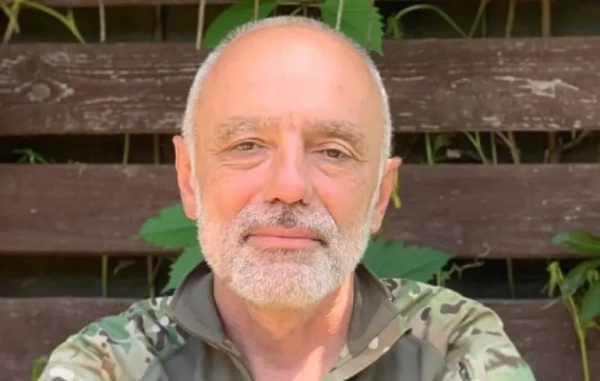
Michigan State University said May 16 it had reached a $500 million settlement with more than 300 women and girls who alleged Larry Nassar, the former USA Gymnastics and Michigan State University doctor, sexually abused them.
The university will pay out $425 million, and set aside another $75 million for survivors who may come forward in the future. The payout far exceeds the $109 million Penn State paid to its more than 30 victims in the case of former assistant football coach Jerry Sandusky, who was convicted of molesting young boys in 2012.
The settlement should resolve the scores of lawsuits against MSU, and it represents the harshest consequences yet for a university that has grappled with a slow burning crisis for months. MSU president Lou Anna Simon resigned in January, hours after Nassar’s sentencing. William Strampel, the former dean of MSU’s College of Osteopathic Medicine and Nassar’s former boss, was charged with crimes related to sexual misconduct and abuse of power. The MSU athletic director also retired.
The Department of Education has opened a formal investigation into the university. So has the NCAA. Michigan Attorney General Bill Schuette embarked on a “full review” of the Nassar case and the failures of MSU, appointing a special prosecutor to lead the probe.
Families and onlookers have demanded that the university, as well as USA Gymnastics, reckon with its role in the scandal and explain how a doctor accused of molesting about 300 women and girls did not face real consequences for decades.
That silence enabled Nassar to become perhaps the worst known sexual predator in American sports history.
At Nassar’s sentencing hearing, 15-year-old Emma Ann Miller told the court Nassar had molested her in August 2016 at MSU. The university suspended him about a week after, she said, and she offered a chilling thought: “I’m possibly the last child he will ever assault.”
Her mother, Miller added, was still getting bills from MSU sports medicine — bills, she said, “for appointments where I was sexually assaulted.”
Women reported Nassar to MSU representatives as early as the 1990s
Nassar’s medical career is deeply entwined with Michigan State University. He attended medical school there, and he served on the faculty and saw patients at the university starting in 1997.
Nassar had, at that point, already established his relationship with USA Gymnastics — a résumé booster that helped burnish his reputation at MSU and in the area’s gymnastics community.
But complaints against him reportedly began almost as soon as his tenure did. ESPN Outside the Lines interviewed four women who said they told MSU coaches or trainers about Nassar as far back as the 1990s.
Two women said they told Kathie Klages, MSU’s longtime gymnastics coach, in 1997 that they felt uncomfortable about Nassar’s behavior during appointments. One was a 14-year-old girl at the time, and the other was 16-year-old Larissa Boyce, who was participating in a youth gymnastics program sponsored by the university.
Boyce said she told Klages that Nassar put his fingers inside her during treatment, and, according to Boyce, Klages dismissed the story because she knew and trusted Nassar.
Klages retired last February, almost immediately after the university suspended her.
But others came forward even after Boyce. Tiffany Thomas Lopez, a former MSU softball player, told ESPN she complained about Nassar to three athletic trainers in 1998:
MSU runner Christine Achenbach said she told a coach about Nassar in 1999. That complaint, too, went nowhere.
A separate Detroit News investigation found that no fewer than 14 MSU coaches, trainers, and other representatives knew of allegations against Nassar in the nearly 20 years before his arrest. At least eight women — including the four athletes who talked to ESPN — and girls had made complaints, including one who contacted local police officials in 2004.
A 2014 Title IX investigation into Nassar raised red flags
University officials also learned of complaints against Nassar after Michigan State launched a Title IX investigation into the doctor in 2014. Amanda Thomashow, then a recent MSU graduate, reported to university officials that she had visited Nassar’s clinic for hip pain and he had massaged her breasts and vaginal area. Thomashow said he stopped only after she physically took his hands off her.
Nassar told investigators his procedures were medically necessary, including touching patients’ breasts. Investigators also interviewed other medical and sports medicine professionals, and all agreed the procedure was medically sound. According to the Detroit Free Press, the university consulted four experts to draw their conclusions — all of whom had ties to Nassar.
The university closed the investigation after three months, in July 2014. It dismissed the woman’s claim, concluding that she hadn’t understood the “nuanced difference” between sexual assault and an appropriate medical procedure.
After the Title IX investigation began, both MSU police and local prosecutors in Ingham County started a criminal investigation as well. But Nassar was allowed to return to work and saw patients even as those investigations were ongoing. The MSU police closed their investigation in July 2015; local prosecutors declined to prosecute in December 2015.
Nassar’s superiors did put restrictions on him, including having another person present in the room when practicing treatment that involved sensitive areas. William Strampel, the dean of Michigan State’s osteopathic medical school and Nassar’s boss, reportedly told police he did not “see the need to follow up to ensure” the doctor had been following those rules. Strampel took a medical leave of absence in December. In February, MSU administrators moved to revoke his tenure and terminate him.
Now, Strampel faces criminal charges for his role in failing to protect students from Nassar. He has also been accused of sexual misconduct in his own right; a criminal complaint claims he made explicit comments to female students and solicited nude photos from another female student.
The MSU interim President John Engler said in a statement about Strampel’s dismissal that he “did not act with the level of professionalism we expect from individuals who hold senior leadership positions, particularly in a position that involves student and patient safety.”
And in what now reads as a hint of the criminal charges soon to come, Engler added that “further, allegations have arisen that question whether his personal conduct over a long period of time met MSU’s standards. We are sending an unmistakable message today that we will remove employees who do not treat students, faculty, staff, or anyone else in our community in an appropriate manner.”
MSU will pay out $500 million to Nassar victims
Michigan State University will pay $500 million to more than 300 women and girls who say Nassar abused them. The eye-popping figure was reached through private negotiations, with help from a mediator, between the university and lawyers for 332 plaintiffs, according to the Associated Press. The university’s board of trustees approved it on Tuesday.
Most of the $500 million — $425 million — will be split between the more than 300 people, each receiving between $250,000 and $2.5 million, according to an attorney for dozens of the victims. The other $75 million will be set aside for victims who may not have come forward yet. (The lawsuits with MSU has no bearing on separate litigation with USA Gymnastics and the US Olympic committee. )
“We are truly sorry to all the survivors and their families for what they have been through, and we admire the courage it has taken to tell their stories,” Brian Breslin, chair of Michigan State’s governing board, said, according to the Associated Press. “We recognize the need for change on our campus and in our community around sexual assault awareness and prevention.”
MSU has not said how it will pay for the nearly half-billion dollar settlement. The university’s endowment totals about $3 billion. Colleges typically have insurance to cover liability risks, but in the Penn State case, one insurer balked at covering the cost of the claims because it argued the university should have acted more aggressively to stop Sandusky. (Penn State and the insurer reached a settlement in 2016.)
Nassar’s victims had mixed reactions to the settlement — a victory for victims, but one that still fails to address the institutional failures that allowed Nassar to victimize so many women for so long. ”I am thankful that the historic settlement amount at least in part reflects the horrific nature of what took place at MSU,” Rachael Denhollander, the first woman to speak publicly about Nassar in 2016, said in a statement. “However, I am deeply disappointed at the missed opportunity for meaningful reform and change at the University.
Multiple investigations into MSU are underway
The university is now under investigation by the federal government, which is looking into whether it violated laws that require colleges to disclose crimes on campus. The Department of Education notified the university on January 18 of its inquiry — though it will likely take years to complete.
The Clery Act requires colleges that receive federal financial aid to disclose crime and public safety statistics. It’s essentially a consumer protection law — unlike Title IX, which is a civil rights issue.
Financial penalties are the main enforcement for Clery violations, but investigations often initiate improvements and overhauls to campus policies, said Alison Kiss, the executive director of the Clery Center. Penn State, after the Sandusky case, set the record for a Clery violation, after the Department of Education fined the university close to $2.4 million for failing to disclose information about Sandusky and other crimes.
Kiss said Clery investigations are usually just the starting point. Even as investigators home in on Nassar, she said, they might uncover other safety or reporting gaps along the way. Those could lead to more penalties.
The House Oversight Committee has also launched a probe into the Nassar scandal, which includes Michigan State.
In addition to the federal investigation, the Michigan attorney general appointed a special prosecutor to investigate the university. AG Bill Schuette said that “no individual or department is off-limits” from the investigation.
The NCAA has also launched an investigation into Michigan State over the Nassar case, examining any possible “rules violations.” That could possibly result in sanctions for the school or fines — though, as SB Nation points out, the situation is a bit knotty because while athletes alleged abuse, Nassar wasn’t actually a member of the athletic department.
MSU has confirmed, in a response to the NCAA’s investigation, that 25 of the women abused were student-athletes. But MSU officials also asserted no NCAA rules were violated. “I trust you will see that the University is in no way attempting to sidestep the issues facing it, and that if the University had any reason to believe the criminal conduct of Nassar also implicated NCAA rules violations, the University would accept responsibility in that area as well,” the MSU letter to the NCAA said, concluding that after an “analytical examination” it found no NCAA violations.
Nassar has sparked broader concerns about MSU’s handling of sexual assault cases
The handling of the Nassar case — and now the charges against Strampel — has raised questions about systemic problems across MSU athletics when it comes to the handling of sexual misconduct allegations.
A separate and sweeping ESPN Outside the Lines report in February by Paula Lavigne and Nicole Noren found what they called a “pattern” of MSU officials bungling complaints of sexual assault or violence, or being less than transparent with the public about those investigations.
The ESPN report revealed alleged problems within two of the university’s most high-profile sports: football and men’s basketball, including alleged instances where sexual assault claims were handled by the athletic department or coaches.
According to their investigation, 16 MSU football players have been accused of sexual assault or violence since the 2007 season, including some previously unreported cases. Four football players were disciplined last year for sexual assault; all were dismissed from the team and university, and one faced criminal charges. The consequences for the other players were unclear, according to ESPN.
Another alleged 2010 rape case involving two basketball players drew media coverage and MSU student protests, but the players were never suspended from the team.
That MSU counselor, Lauren Allswede, who stepped down in 2015 after seven years, told ESPN: “Whatever protocol or policy was in place, whatever frontline staff might normally be involved in response or investigation, it all got kind of swept away and it was handled more by administration [and] athletic department officials.”
MSU football coach Mark Dantonio disputed the ESPN report, saying in January that “when we find out about the problems, it has come from the police or university authorities. I can assure you in last year’s incidents I also immediately reported them to the proper authorities.”
Basketball coach Tom Izzo said that “we’ll cooperate with any investigation and always have.”
What comes next?
The Sandusky scandal at Penn State is probably the closest analog to what Michigan State is facing in the Nassar fallout, though far more victims have come forward in the Nassar case.
Sandusky, a former Penn State defensive coordinator, was convicted in 2012 of sexually assaulting 10 boys over 15 years. He had worked for legendary head coach Joe Paterno, and though he retired in 1999, he retained an office at the university and access to the facilities. He also ran a charity, Second Mile, for troubled kids, which prosecutors alleged he used to groom his victims.
Sandusky had been investigated as early as 1998 by Penn State police, but no charges had been brought. Then in 2001, an assistant coach told Paterno he saw Sandusky in the shower with a 10-year-old boy; Paterno reported it to the athletic director and campus administrator, who failed to act on the report.
Sandusky was charged nearly 10 years later, in 2011, before his conviction in June 2012.
Penn State University faced staggering financial consequences and has paid out about a quarter of a billion so far, including lawsuits to about 35 victims that have totaled more than $100 million. Michigan State’s settlement has already exceeded that amount, with multiple investigations pending.
Louis Freeh, a former FBI agent, was hired by the Penn State board of trustees to investigate the Sandusky scandal and delivered an excoriating condemnation of the administration, including then-president Graham Spanier and legendary football coach Joe Paterno, who died shortly after he was fired.
A criminal investigation also eventually led to charges for Spanier, former athletic director Tim Curley, and former vice president Gary Schultz for failing to alert authorities after that 2001 complaint against Sandusky, which, according to prosecutors, allowed him to continue his abuse.
“Let me tell you two words that you’ll probably see very, very often: ‘Move forward,’’ Smith told Vox about Michigan State’s approach to the crisis.
“The mantra will be, ‘Move forward,’ and that’s exactly what happened at Penn State,” Smith continued. “They wanted to move forward and not deal with anything in the crisis. If Michigan State does that it’s going to be a major problem for them — as it was at Penn State.”
MSU would like to avoid the comparison to Penn State. One board of trustees member had to apologize for dismissing the Nassar case as “not Penn State.”
The various investigations will likely play out over the course of months or, likely, years, meaning this is far from over for Michigan State. But either way, the results will likely be damning if university officials knew and did not act, or if university officials somehow didn’t know, revealing alarming institutional breakdowns.
“I told somebody,” Larissa Boyce recalled of her 16-year-old self during Nassar’s sentencing hearing. “Instead of being protected, I was humiliated and told that I was the problem.”
Boyce tried to speak out against Nassar in 1997. She is now 37 years old; her husband is a teacher at the local high school. In addition to his wife, one of his former students also testified at Nassar’s sentencing, he told the New York Times. It was Emma Ann Miller, the teenager who saw Nassar before his firing — the one who said in court, “I’m possibly the last child he will ever assault.”
Sourse: vox.com






